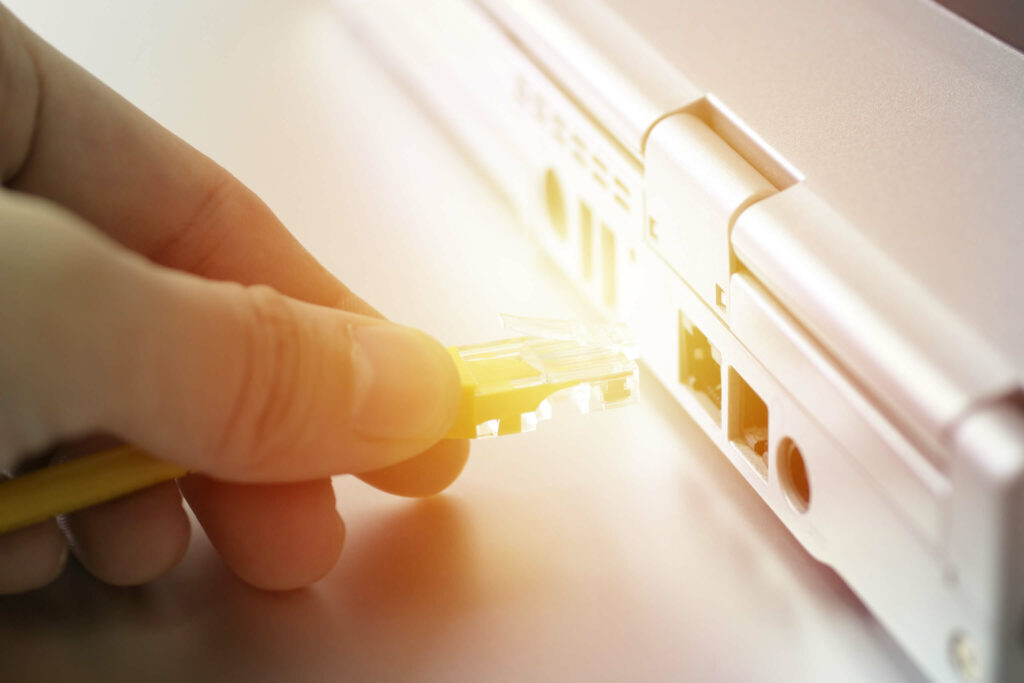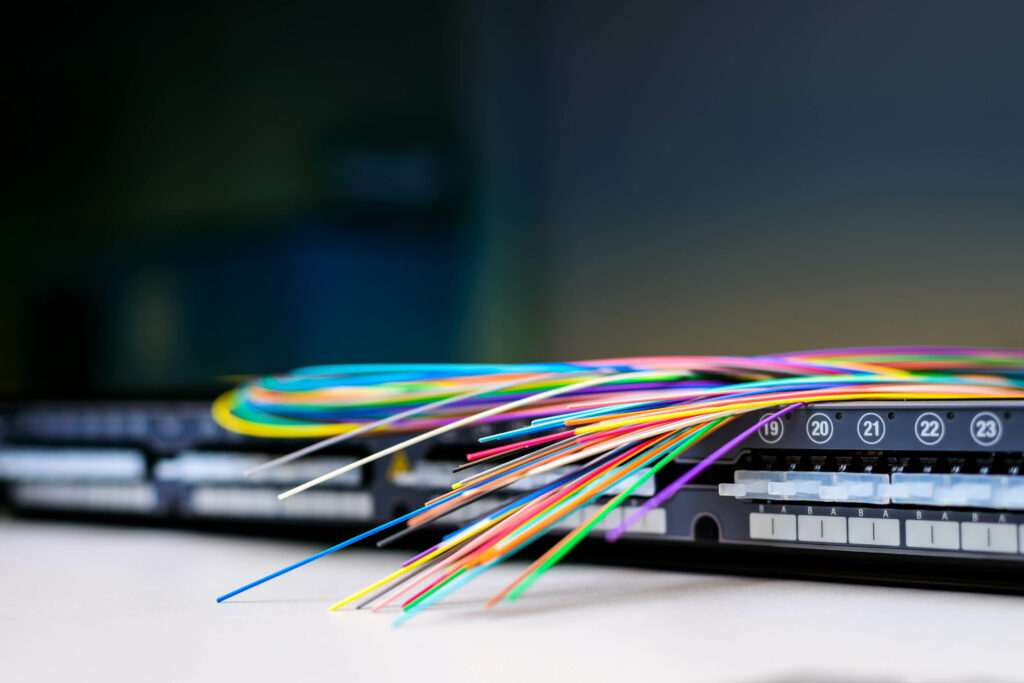
Insights
What is FTTP?
One of the many acronyms you may notice on adverts for ultrafast broadband is ‘FTTP’. This stands for ‘Fibre to the Premises’. Instead of old copper wires carrying the data signal at any point between the exchange and your property, you get all the benefits of a complete fibre connection for all the services your household could possibly need. Let’s dig into the details a little more…
Explaining fibre-optic broadband
Modern communications technology relies on faster and faster internet speeds. Fibre-optic cables are key in providing those speeds and allowing everyone in the country to enjoy everything life has to offer.
Instead of using a copper wire core to transmit an electric signal, a fibre-optic line uses a strand of clear plastic or silica to transfer data literally at the speed of light. This makes it far more efficient than traditional lines, with a lot less degradation or resistance over longer distances. Fibre-optic cables have the potential to reach speeds of 1Gbps, although this is rarely necessary in a domestic setting.
The result is that our computers, games consoles, smartphones, tablets, televisions and other internet-capable devices are able to function seamlessly – in a way that copper wires or even a ‘superfast’ connection can’t match – even with multiple users online at the same time.
What’s the difference between FTTP and FTTC?
You’ll find that many providers offering a ‘superfast’ service often mention ‘FTTC’. This stands for ‘Fibre to the Cabinet’, the cabinet being the green junction box positioned on streets that forms a hub for lines running to all the homes nearby. The connection between the on-street cabinet and your property will still be copper wire, which accounts for a degradation in the internet speed down to around 30-60Mbps for downloads.
What about standard broadband?
Thanks to the government’s efforts to give more regions in the UK access to a superfast broadband connection, an increasing number of places now have fibre-optic lines between on-street cabinets and the local exchange. However, there are still many more towns, villages and communities where fibre cables are yet to be installed.
If your area is still waiting for a fibre connection, you’ll be relying on standard copper lines at every stage between your home and the exchange. This is known as ADSL broadband, and while it’s still workable for those who only need to send emails, browse social media and make the occasional online purchase, with download speeds of between 9-24MBps, it’s far from sufficient if you want to stream films, download large files or join your friends online for a spot of gaming.
FTTP speeds
Full-fibre speeds easily dwarf those achieved by ADSL and FTTC. With an ultrafast broadband connection and an up-to-date router, you can expect download speeds of at least 300Mbps and even as fast as 950Mbps in most cases.
A few other factors will influence the final speed you are able to experience with your device or television, such as the wiring you use in the home, the capacity of your router, the number of users sharing the line at any particular time and your device’s processing speed. But whatever the circumstances, the final results with FTTP will be far superior to the alternatives.

What are the other benefits of FTTP?
Aside from raw speed, a full FTTP line has a few other key advantages over a standard or FTTC connection.
Durability
Copper wires become far less efficient in colder temperatures, and connections are often affected by damp conditions. On the other hand, fibre-optic cables operate to the same capability in any temperature range, and are far less susceptible to corrosion or dampness hindering the signal.
Greater connectivity
In addition to an immunity to the environment, fibre-optic cables are not affected by any electrical interference (from other cables, devices, transmitters or even lightning) and offer far less resistance to the data signal across distances, so the strength will not decline the further away you are from the exchange or junction box.
Value to the property
Getting a FTTP line installed direct to your home provides a valuable asset that will only become more desirable as modern technology evolves. If you ever come to sell your property, potential buyers will see this as a definite plus point.
Why should I get FTTP?
Most people don’t realise how much more bandwidth and memory is required for our improved home entertainment and technology to function properly. Even in the last couple of years, increased definition, faster gaming processors and simply the growing number of online or cloud-based services have all created the need for greater signal capacity, speed and strength.
At home, you may be happy with your current provision if you are only using the internet to send emails (without large attachments), browse social media and occasionally check online banking.
However, as soon as you start using a lot of on-demand TV, live sports streams, music streaming, subscription film and TV services, video calls and online tools or documents – and especially if you live in a shared or family home with multiple people online at the same time – your broadband is going to show signs of strain, or drop out altogether.
Getting an ultrafast FTTP connection in your home will enable convenient, seamless enjoyment of:
- Video calls – for example via Zoom, Microsoft Teams, Skype or Google Chat
- Films and boxsets – using services like Netflix, Amazon Prime, Disney+ and all ‘catch up’ services offered by the main TV channels
- Sports – live coverage from a host of events via streaming services such as Sky
- Online gaming – joining friends for a high-definition multi-player experience
- Social media – YouTube videos and Facebook Live events
- Music – using streaming platforms like Spotify, Apple Music and of course YouTube again
- Downloads – of games, music and podcasts, as well as brochures and pictures
- Education – remote learning now plays a greater role for many colleges and universities
- Domestic connections – your central heating, oven, energy supply meters and more can now be controlled or send information online
- Smart home devices – including smart speakers like Amazon Alexa and Google Home, plus other domestic appliances that can be controlled remotely via WiFi.

Building the fibre-optic infrastructure
All these services and amenities require physical fibre cables – in the ground from the exchange and to the premises – in order to be able to work. Fortunately, many parts of the UK now enjoy fibre cables as part of the telephone network, meaning we just need to connect your home to the local lines.
However, there are sadly still a significant number of areas that are yet to get a fibre connection. That’s why we’re investing millions of pounds in a network to reach more households and communities across the South West and, we hope, further afield in future.
Can I get fibre broadband?
Full-fibre broadband is now available in many regions across the South West, and we are continuing our work to install the much-needed infrastructure in others. Is your home eligible for an ultrafast broadband upgrade?
What Jurassic Fibre’s ‘Fibre to the Premises’ means for you
Our multi-million pound network – built by people in the South West, for people in the South West – is designed to improve the lives and futures of everyone in the region.
We know the issues and excuses you have had to put up with from other providers over the years, because we live and work here too. The South West’s businesses, communities and homes should have the broadband they need and deserve.
As part of our service, you also get:
- Local support – be looked after by a friendly local team
- Simple contracts – Fixed-price or monthly rolling contracts, you choose
- Upgrade/downgrade – once a month you can upgrade or downgrade your packages
Sound good?
Take the first step towards an ultrafast full-fibre future today. Use our postcode checker to see your connection status right now.
Or if your local network is already fibre-enabled, call our team on 01392 345600 and get on the road to your own ultrafast FTTP connection.
Latest news
A network for the future
Why Jurassic Fibre?


